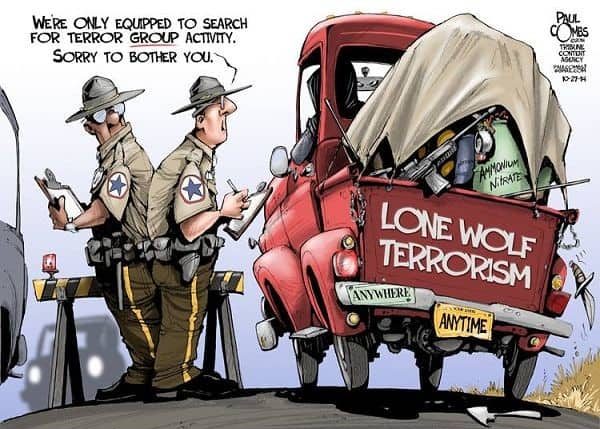
21 Jul Lone Wolf Terrorism: Can It Be Prevented?
Abstract
Lone wolf terrorism has become an increased threat to national security in the United States over the past several decades. As training for law enforcement has become hyper-focused in response to such incidents, prevention has taken a proverbial back seat. Meanwhile, politicians and the media use the term ‘lone wolf’ as nothing short of an excuse, as if the term alone explains why the attack was not thwarted. But is this assessment correct? Could it be possible to prevent an attack perpetrated by an individual, acting alone but on behalf of extremist ideologies and through the indirect guidance of a terrorist organization? This paper seeks to answer this question through a review of both empirical data and literature.
Lone wolf attacks have become increasingly more prevalent in the United States; however, this was not always the case. Between the 1960s and 1980s, terrorist organizations held a more hierarchical structure. It was common for an organization to have a clandestine military branch with a very public political front. This changed in the 1990s with the creation of flatter organizational models. Small cells of organization members began operating independently of one another. It was believed that if one cell were caught, members would not be capable of revealing information about subsequent cells. Cells have become increasingly smaller to include just one person. This concept has come to be known as ‘lone wolf’ terrorism (Martin, 2011).
The internet has made it easier for terrorist organizations to reach supporters, distribute recruiting propaganda, and disseminate training manuals (al-Qaeda, 2017; see also ISIS, n.d.). According to Ophir and Morgenstern (2009), these individuals utilize online propaganda and manuals to plan and carry out attacks independently. The lack of interceptable communication has made it nearly impossible to stop attacks in the planning stages. Although most lone-wolf attacks have been claimed by the terrorist organizations they professed to support (al-Qaeda, 2017; see also ISIS, n.d.), there remains an unwillingness for government officials and media outlets to identify them as members of these organizations or even identify the perpetrator as a terrorist. Does this beg the question is a lone wolf attacker a terrorist?
Can It Accurately Be Defined?
Existing research and literature was found to use the terms ‘lone wolf attack’ and ‘lone wolf terrorism,’ as well as ‘lone wolf actor’ and ‘lone wolf terrorist’ interchangeably. For that reason, this paper will do the same. Moskalenko and McCauley (2010) stated that although the government has defined ‘terrorism,’ it has not provided a definition of the term ‘lone wolf.’ They further contend that because the terrorism definition included verbiage such as ‘groups’ and ‘clandestine agents,’ then it leads one to believe that lone wolf terrorism is an oxymoron. The authors have suggested that is not possible to be part of an organization and a lone agent. This has not stopped other researchers from producing their own definitions without citing from where said definition originated.
Spaaij (2010) suggested that law enforcement officials had defined lone wolves as “terrorists who carry out attacks individually and independently from established terrorist organizations” (p. 854). He elaborated on this definition by stating the acts were “carried out by persons who (a) operate individually, (b) do not belong to an organized terrorist group or network, and (c) whose modi operandi are conceived and directed by the individual without any direct outside command or hierarchy” (p. 854). The problem with these definitions is the use of words like ‘independently’ and ‘individually.’ Is it still independent if the individual subscribed to the same ideologies, read the organization’s recruiting propaganda, perpetrated the attack in accordance with the guidelines provided in said propaganda, and claimed allegiance to the organization? Must official communication between the individual and the organization first be established? Is it implied that proof of affiliation comes in the form of a paid invoice for association dues or perhaps a membership card?
In a later publication, Spaaij (2014) admitted the definition was part of the issue with existing research. He praised Becker (2014) for his more specific description of an “ideologically driven violence or attempted violence, perpetrated by an individual who plans and executes an attack in the absence of collaboration with other individuals or groups” (p. 960). While criticizing others (Hewitt, 2003; and Simon, 2013) for being too broad and including small cell groups. Spaaij (2014) contended two or more people working together to perpetrate an attack could not be considered ‘lone.’
Referencing a statement made by former Director of the Federal Bureau of Investigation (FBI), Robert S. Mueller III, in 2003; Spaaij (2010) suggested the defining aspect had to do more with “external support” (p. 854) as well as a lack of “direct influence [and] advice” (p. 866). However, this too can be questioned as the author does not address what constitutes ‘external support,’ ‘direct influence,’ or even ‘advice.’ Is training a form of external support? Does training need to be conducted in a training facility or can it be provided in an instructional manual published on the internet? Could recruiting propaganda not be considered a direct influence or advice?
Ophir and Morgenstern (2009) contended that lone wolf terrorist attacks are incited by propaganda and that the determining factor as to whether or not the act is terrorism, should be made by the intended target and the motivation behind the attack. Moskalenko and McCauley (2010) noted that although lone wolf actors may carry out the attack by themselves, they have always demonstrated some type of connection with a greater movement. Chodoff (2017) argued the concept of ‘lone wolf’ was misleading because radicalization could not occur in a vacuum. Despite Spaaij’s (2010) remarks, he too made this assessment.
Capellan (2015) suggested lone wolf attacks were one in the same with mass murders and active shooters because nearly 75 percent were found to be motivated by extreme ideologies. Gill, Silver, Horgan, and Corner (2017) appeared to agree with this statement but suggested the actors differed “in the ratio to which they are personally versus politically aggrieved” (p. 714). The literature would appear to indicate the term either does not require its own definition or is flawed and any attempt to define it is futile.
What Does Research Say?
According to Spaaij and Hamm (2014), despite the growing number of lone wolf attacks both in the United States and abroad, the research on the topic is scarce. The focus for researchers had consistently surrounded the dynamics of the organizations and only focused on the individual members when researchers sought to explain what had led an individual to join. Although once helpful, this type of research meant little if the individuals were not officially joining an organization. What the author appeared to assume was that the individual had to officially join in order to be driven by the same organizational ideologies. This may explain the reason counter-terror tactics focus so narrowly on the attackers rather than the ideologies which compel them.
Spaaij (2010) found that one of the primary driving ideologies behind lone wolf attacks was Islamism but also pointed out that this factor tended to be combined with “personal frustrations and aversion with broader political, social, or religious aims” (p. 866); though the author did not elaborate on how that differed from those individuals who were provided external support from or considered to be members of terrorist organizations. Spaaij (2010) also concluded variable levels “of commitment to and identification with” (p. 866) said organizations. Moskalenko and McCauley (2010) appeared to explain Spaaij remarks by stating that commitment or identification was triggered when something occurred which caused the organization’s ideologies to become personal for the lone wolf terrorist. Spaaij (2010) further concluded that not only have the dynamics of a group been known to influence individuals, but individuals or lone wolves have been known to influence the ideology and subsequent organizations which they claimed to support. This has been demonstrated in the multiple article publications in terrorist propaganda magazines which not only claimed lone wolf actors but also glorified their actions (al-Qaeda, 2017; see also ISIS, n.d.).
In a comparison between the mental health of lone wolf attackers and that of terrorist organizational members, Spaaij (2010) stated there appeared to be a higher rate of identifiable psychopathology in lone wolf terrorists than in organizational terrorists; citing specifically obsessive-compulsive and personality disorders. Though admittedly, the extent to which their mental disorder directly impacted their violent action was not clear.
Meloy and Yakeley (2014) concluded that psychiatrists have been unable to agree in their assessments of some lone wolf attackers as to whether they suffered from psychotic illness or personality disorder. They go as far as to state, “the mind of the lone wolf has at its foundation a pathologically narcissistic self-structure in which primitive modes of thinking predominate” (p. 362). However, this research does not appear to have accounted for cultural differences. Gill et al. (2017) came the closest as he cautioned that such behaviors should not be so quickly dismissed as mental illness. “Sometimes personal problems led to a susceptibility to ideological influences…[and] long-held ideological influences became intensified after the experience of personal problems” (p. 713).
Can It Be Detected?
Some researchers have suggested that it is possible to identify lone wolf terrorists through profiling; identifying them as being older than average white males (Gill, Horgan, & Deckert, 2014). They have further been described as socially awkward isolationists with mental illness (Gill et al., 2014; see also Spaaij, 2010). Such individuals have been known to utilize extremism as a way to direct personal grievances and transfer accountability to others (Spaaij, 2010). Lankford (2010) indicated most were suicidal. In a later publication, Gill et al. (2017) admitted lone wolf terrorist “display no discernable sociodemographic profile” (p. 714) but maintained at least some were socially isolated.
This type of profiling has become unpopular because it has been proven to be ineffectual and at times illegal (Chodoff, 2017). M. Elert (personal communication, May 17, 2018), the current President of the IMI Academy in Israel, indicated that behavioral or situational profiling was a far more effective method of detection. This established a baseline of normal behavior in the context of any given situation. Lone wolf actors, whether assimilating into said baseline too well or not well enough, represented a detectible disruption. Although this model has been taught to Israeli security personnel for some time, it is very limited in its availability in the United States.
Meloy and Gill (2016) believed it might be possible to determine individual indicators if a comparison was made between successful attacks and those which were thwarted. Their study utilized Terrorist Radicalization Assessment Protocol (TRAP-18). TRAP-18 was described as containing “8 proximal warning behaviors and 10 distal characteristics for active risk management” (p. 37). The warning behaviors were pathway warning (planning), fixation, identification, novel aggression, energy burst, leakage (communication), last resort, and direction communicated. The distal characteristics were personal grievance and moral outrage, framed by an ideology, failure to affiliate with an extremist group (either rejected by or rejection of), dependence on the virtual community, thwarting of occupational goals, changes in thinking and emotion, failure of sexual-intimate pair bonding, mental disorder, greater creativity and innovation, and criminal violence. Meloy and Gill (2016) believed the existence of distal characteristics warranted operational monitoring of a subject; while warning behaviors compelled management of a genuine threat.
The data showed lone wolf terrorists who were successful in their attacks scored highest in leakage (90 percent), fixation (84 percent), pathway warning, and identification (both at 72 percent). In contrast, those who were unsuccessful scored highest in pathway warning (93 percent) and only 77 percent in leakage (Meloy & Gill, 2016). This would suggest that although both are predisposed to discuss their plans, it was likely either planning or research and preparation (pathway warning) which allowed for authorities to catch them. It may have also been an indication that those who had no intention of attacking took longer in the planning stage.
The top distal characteristic for both successful and thwarted attackers was framed by an ideology (100 percent). Both groups also scored very close in changes in thinking and emotion; failure of sexual-intimate pair-bonding; and personal and moral outrage. Less than half of either group were found to have a mental disorder. Meloy and Gill (2016) cautioned that these indicators could not account for “unknown artifacts, such as aspects of the investigation, preemptive policing, tips, luck, the year of the interdiction, ideological contributions, and the specific countries in which these different cases occurred” (p. 48).
Can It Be Prevented?
According to Capellan (2015), “a substantial number of plots [were] foiled by law enforcement in the last 15 years” (p. 396). However, contended that because of the difficulty associated with identifying self-radicalized individuals, there will always be some attacks that are successfully executed. Chodoff (2017) disagreed with the fundamentals of such statements as he explained it is not possible to ‘self-radicalize.’ As long as the perpetrators of such attacks were accessing how-to manuals published online by terrorist organizations, supporting the ideologies and disseminating the message through social media accounts, then the intelligence to track and prevent the attacks existed. This appeared to be corroborated in Meloy and Gill’s (2016) study as communication and planning were profoundly demonstrated indicators. M. Elert (personal communication, May 17, 2018) agreed in that if the behavior was detectable, then it was most certainly preventable.
Conclusion
Detection and subsequent prevention of lone wolf attacks are based on the presumption that the limited amount of communication can be intercepted, a concerned citizen is able to observe and report the actor’s suspicious behavior, or through profiling either behavior or person. However, it is important to reiterate that profiling people is at best ineffective and at worst illegal. Advanced training in behavioral/ situational profiling is required but currently limited.
Data on specific lone wolf attacks which have been prevented is scarce. This could be because government agencies are not inclined to share such information or that the details have remained under a classified status. Regardless, the lack of data has made it more challenging to determine tactics which have proven successful in the detection and subsequent prevention of such attacks.
The mental health of lone wolf actors has been a very controversial subject among researchers. It has been implied by some that an individual who conducts a lone wolf attack for the purpose of causing a mass casualty event has mental health issues; but is it crazy to have so much faith in an ideology that one would be willing to kill for it or die themselves? Perhaps this is an example of the application of one society’s norms to explain (or excuse) that of another. Other behavioral and personality indicators have been suggested but appear to be limited in scope.
The term lone wolf terrorism continues to be utilized by researchers despite the lack of consensus as to the elements which constitute the acts. However, the lack of a definition appears to be less of a factor in detection and prevention. That is unless one considers many thwarted attacks are simply not being referred to as lone wolf, while those that are successful are given the title. Currently, there is no research that corroborates such theories.
References
Al-Qaeda. (2017). Inspire, 1438 (17).
Becker, M. (2014). Explaining lone wolf target selection in the United States. Studies in Conflict & Terrorism, 37, 959-979. doi:10.1080/1057610X.2014.952261.
Capellan, J. A. (2015). Lone wolf terrorist or deranged shooter? A study of ideological active shooter events in the United States, 1970-2014. Studies in Conflict & Terrorism, 38, 395-413. doi: 10.1080/1057610X.2015.1008341.
Chodoff, E. (2017). Lecture on The Nature of Terrorist Threats & the Israeli Method of Population Behavior Management in Disasters. Personal Collection of E. Chodoff Hamartzim Educational Services, Israel.
Hewitt, C. (2003). Understanding Terrorism in America. New York, NY: Routledge.
ISIS. (n.d.). Dabiq, 1437 (15).
Gill, P., Horgan, J., & Deckert, P. (2014). Bombing alone: Tracing the motivations and antecedents behaviors of lone-actor terrorists. Journal of Forensic Sciences. 59 (2), 425-35.
Gill, P., Silver, J., Horgan, J., & Corner, E. (2017). Shooting alone: The pre-attack experiences and behaviors of U.S. solo mass murders. Journal of Forensic Sciences, 62 (3), 710-714. doi: 10.1111/1556-4029.13330.
Lankford, A. (2010). Do suicide terrorists exhibit clinically suicidal risk factors? A review of initial evidence and call for future research. Aggression and Violent Behavior, 15, 334–340.
Martin, G. (2011). Terrorism and Homeland Security. Thousand Oaks, CA: Sage Publications, Inc.
Meloy, J. R., & Yakeley, J. (2014). The violent true believer as a “lone wolf” – Psychoanalytic perspectives on terrorism. Behavioral Sciences and the Law, 32, 347-365. doi: 10.1002/bsl.2109.
Meloy, J. R., & Gill, P. (2016). The lone-actor terrorist and the TRAP-18. Journal of Threat Assessment and Management, 3 (1), 37-52.
Moskalenko, S., & McCauley C. (2010). The psychology of lone-wolf terrorism. Counselling Psychology Quarterly, 24 (2), 115-126.
Ophir, F., & Morgenstern, H. (2009). Suicide Terror: Understanding and Confronting the Threat. Hoboken, NJ: John Wiley & Sons, Inc.
Simon, J. D. (2013). Lone Wolf Terrorism: Understanding the Growing Threat. New York, NY: Prometheus.
Spaaij, R. (2010). The enigma of lone wolf terrorism: An assessment. Studies in Conflict & Terrorism, 33, 854-870. doi: 10.1080/1057610X.2010.501426.
Spaaij, R., & Hamm, M. S. (2014). Key issues and research agendas in lone wolf terrorism. Studies in Conflict & Terrorism, 38, 167-178. doi: 10.1080/1057610X.2014.986979.
To view this article on LinkedIn, click here.



Sorry, the comment form is closed at this time.